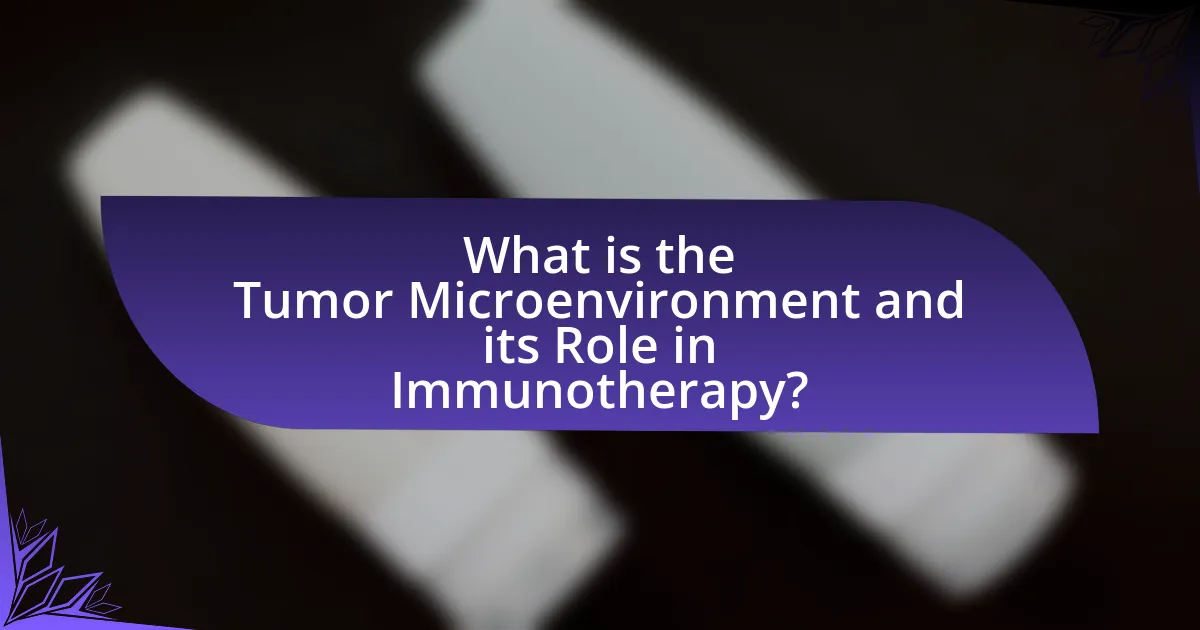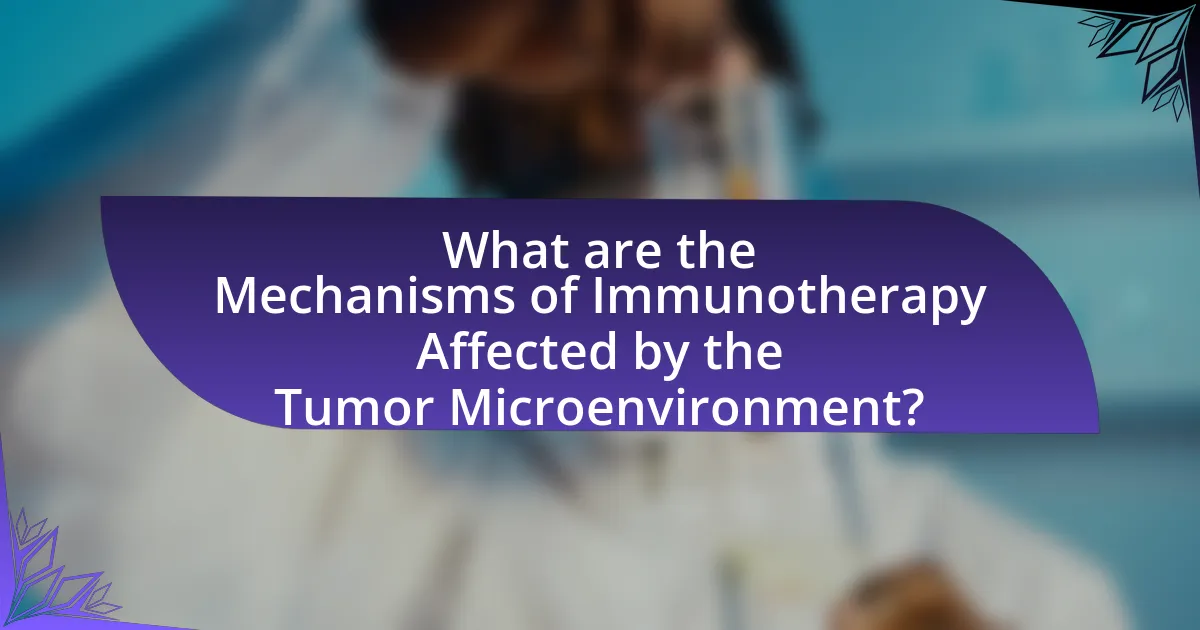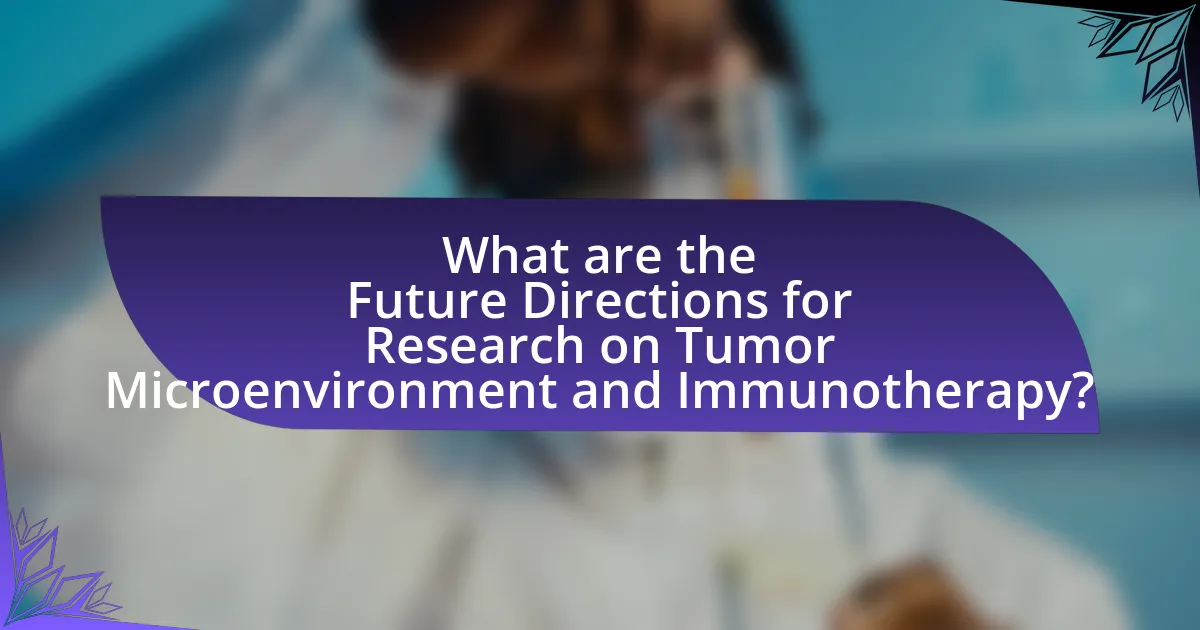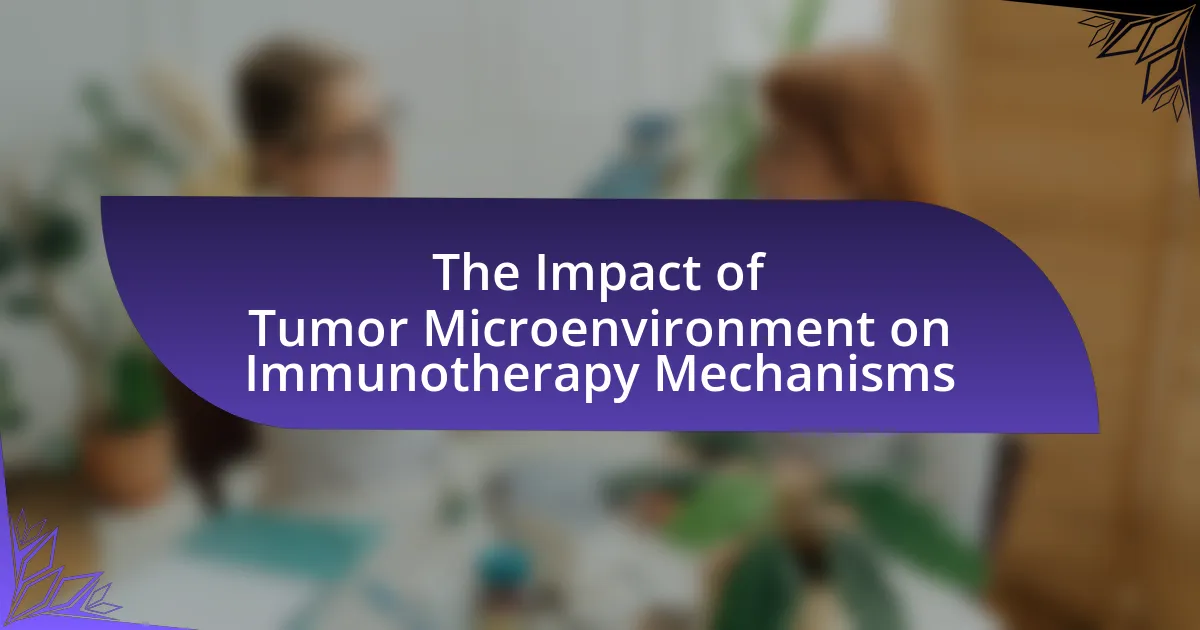The tumor microenvironment (TME) is a complex ecosystem surrounding tumors, comprising various cell types, extracellular matrix components, and signaling molecules that significantly influence the effectiveness of immunotherapy. This article explores how the TME modulates immune responses, detailing the roles of immunosuppressive cells, cytokines, and physical barriers that hinder immune cell infiltration. It highlights the challenges posed by the TME to immunotherapy, including immune evasion and reduced efficacy of treatments like checkpoint inhibitors and CAR T-cell therapy. Additionally, the article discusses strategies for targeting the TME to enhance treatment outcomes and the importance of understanding its dynamics for optimizing immunotherapeutic approaches.

What is the Tumor Microenvironment and its Role in Immunotherapy?
The tumor microenvironment (TME) refers to the complex ecosystem surrounding a tumor, including various cell types, extracellular matrix components, signaling molecules, and blood vessels. The TME plays a critical role in immunotherapy by influencing the effectiveness of immune responses against cancer cells. For instance, the presence of immunosuppressive cells, such as regulatory T cells and myeloid-derived suppressor cells, can inhibit the activity of effector T cells, thereby reducing the efficacy of immunotherapeutic agents. Additionally, the TME can create physical barriers that hinder the infiltration of immune cells into tumors, further complicating treatment outcomes. Studies have shown that modifying the TME can enhance the response to immunotherapy, highlighting its importance in cancer treatment strategies.
How does the Tumor Microenvironment influence immune responses?
The tumor microenvironment significantly influences immune responses by modulating the behavior of immune cells and altering their effectiveness against tumors. This environment is characterized by various factors, including the presence of immunosuppressive cells, such as regulatory T cells and myeloid-derived suppressor cells, which inhibit anti-tumor immunity. Additionally, the secretion of cytokines and chemokines by tumor cells can create a hostile environment that promotes immune evasion. For instance, studies have shown that tumors can upregulate the expression of immune checkpoint molecules like PD-L1, which further dampens T cell activation and proliferation. This interplay between the tumor microenvironment and immune cells is crucial for understanding the mechanisms of immunotherapy and developing effective treatment strategies.
What are the key components of the Tumor Microenvironment?
The key components of the Tumor Microenvironment (TME) include cancer cells, stromal cells, immune cells, extracellular matrix (ECM), and signaling molecules. Cancer cells form the core of the TME, while stromal cells, such as fibroblasts and endothelial cells, provide structural support and facilitate nutrient exchange. Immune cells, including T cells, macrophages, and dendritic cells, play crucial roles in tumor immunity and response to therapies. The ECM, composed of proteins and carbohydrates, influences cell behavior and tumor progression. Signaling molecules, such as cytokines and growth factors, mediate communication between these components, affecting tumor growth and response to immunotherapy. Research indicates that the TME significantly impacts the efficacy of immunotherapies, as it can either promote or inhibit immune responses against tumors.
How do these components interact with immune cells?
Tumor microenvironment components, such as cytokines, extracellular matrix proteins, and immune suppressive cells, interact with immune cells by modulating their activity and function. For instance, cytokines like TGF-beta can inhibit T cell proliferation and promote regulatory T cell differentiation, leading to immune suppression. Additionally, extracellular matrix proteins can create physical barriers that hinder immune cell infiltration into tumors. Studies have shown that tumor-associated macrophages can secrete factors that further suppress T cell responses, illustrating the complex interplay between these components and immune cells. This interaction ultimately influences the efficacy of immunotherapy, as a hostile tumor microenvironment can limit the effectiveness of immune-based treatments.
Why is understanding the Tumor Microenvironment crucial for immunotherapy?
Understanding the Tumor Microenvironment is crucial for immunotherapy because it directly influences the efficacy of immune responses against tumors. The Tumor Microenvironment consists of various cells, signaling molecules, and extracellular matrix components that can either promote or inhibit immune activity. For instance, immunosuppressive cells like regulatory T cells and myeloid-derived suppressor cells can hinder the effectiveness of immune checkpoint inhibitors, which are a common form of immunotherapy. Research has shown that tumors with a more favorable microenvironment, characterized by a higher presence of cytotoxic T cells and lower levels of immunosuppressive factors, respond better to immunotherapy treatments. Therefore, comprehending the dynamics of the Tumor Microenvironment is essential for optimizing immunotherapeutic strategies and improving patient outcomes.
What challenges does the Tumor Microenvironment pose to immunotherapy?
The Tumor Microenvironment (TME) presents significant challenges to immunotherapy by creating a suppressive environment that hinders immune response. The TME is characterized by the presence of immunosuppressive cells, such as regulatory T cells and myeloid-derived suppressor cells, which inhibit the activation and function of effector T cells. Additionally, the TME often exhibits a dense extracellular matrix and hypoxic conditions, which can physically obstruct immune cell infiltration and limit the efficacy of therapeutic agents. Studies have shown that these factors contribute to the failure of various immunotherapies, as evidenced by the limited response rates observed in many cancer patients undergoing treatment.
How can targeting the Tumor Microenvironment enhance treatment efficacy?
Targeting the Tumor Microenvironment (TME) can enhance treatment efficacy by modifying the immunosuppressive conditions that tumors create, thereby improving the effectiveness of immunotherapies. The TME is composed of various cells, extracellular matrix components, and signaling molecules that can inhibit immune responses against tumors. By targeting these elements, therapies can disrupt the protective niche that tumors exploit, allowing for a more robust immune attack on cancer cells. For instance, studies have shown that inhibiting immune checkpoint proteins within the TME can lead to increased T-cell activation and proliferation, resulting in better tumor control. Additionally, targeting stromal components, such as fibroblasts and immune cells, can alter the TME to become more permissive for immune infiltration, further enhancing the efficacy of treatments like checkpoint inhibitors and CAR T-cell therapy.

What are the Mechanisms of Immunotherapy Affected by the Tumor Microenvironment?
The mechanisms of immunotherapy affected by the tumor microenvironment include immune evasion, altered immune cell infiltration, and modulation of immune responses. The tumor microenvironment can create a suppressive milieu that inhibits the activation and function of immune cells, such as T cells and natural killer cells, thereby allowing tumors to evade immune detection. For instance, the presence of immunosuppressive cells like regulatory T cells and myeloid-derived suppressor cells can significantly diminish the efficacy of immunotherapeutic agents. Additionally, the secretion of cytokines and chemokines by tumor cells can alter the recruitment and activation of immune cells, further impacting the effectiveness of therapies like checkpoint inhibitors and CAR T-cell therapy. Studies have shown that targeting the tumor microenvironment can enhance the response to immunotherapy, highlighting its critical role in shaping therapeutic outcomes.
How does the Tumor Microenvironment modulate immune checkpoint inhibitors?
The tumor microenvironment modulates immune checkpoint inhibitors by influencing the immune response and altering the efficacy of these therapies. Factors such as the presence of immune cells, cytokines, and extracellular matrix components within the tumor microenvironment can either enhance or inhibit the activity of immune checkpoint inhibitors. For instance, high levels of immunosuppressive cells, like regulatory T cells and myeloid-derived suppressor cells, can diminish the effectiveness of checkpoint blockade by inhibiting T cell activation and function. Additionally, the secretion of immunosuppressive cytokines, such as TGF-beta and IL-10, can further create a hostile environment for immune responses, thereby reducing the therapeutic impact of immune checkpoint inhibitors. Studies have shown that the composition and characteristics of the tumor microenvironment are critical determinants of treatment outcomes, highlighting the need for strategies that can modify this environment to improve the efficacy of immunotherapy.
What specific factors in the Tumor Microenvironment affect checkpoint inhibitor efficacy?
Specific factors in the Tumor Microenvironment that affect checkpoint inhibitor efficacy include the presence of immune suppressive cells, such as regulatory T cells and myeloid-derived suppressor cells, as well as the secretion of immunosuppressive cytokines like TGF-β and IL-10. These elements can inhibit T cell activation and function, thereby reducing the effectiveness of checkpoint inhibitors. Additionally, the extracellular matrix composition and hypoxic conditions within the tumor can further hinder immune responses, impacting the overall efficacy of immunotherapy. Studies have shown that tumors with a high density of immune suppressive cells correlate with poorer responses to checkpoint blockade therapies, highlighting the critical role of the Tumor Microenvironment in shaping treatment outcomes.
How can we overcome resistance to checkpoint inhibitors in the Tumor Microenvironment?
To overcome resistance to checkpoint inhibitors in the tumor microenvironment, strategies such as combination therapies, modulation of the immune landscape, and targeting specific signaling pathways can be employed. Combination therapies, which include the use of checkpoint inhibitors alongside other treatments like chemotherapy or targeted therapies, have shown enhanced efficacy by addressing multiple mechanisms of resistance. For instance, studies have demonstrated that combining anti-PD-1 therapy with anti-CTLA-4 therapy can lead to improved outcomes in melanoma patients, as reported in the research by Wolchok et al. (2013) in the New England Journal of Medicine. Additionally, modulating the immune landscape through the use of agents that alter the tumor microenvironment, such as anti-angiogenic therapies, can improve T-cell infiltration and function. Targeting specific signaling pathways, such as the PI3K/AKT/mTOR pathway, can also help to restore sensitivity to checkpoint inhibitors by enhancing T-cell activation and proliferation. These approaches collectively aim to create a more favorable immune environment that can effectively respond to checkpoint blockade.
What role does the Tumor Microenvironment play in CAR T-cell therapy?
The Tumor Microenvironment (TME) significantly influences the efficacy of CAR T-cell therapy by affecting T-cell activation, persistence, and function. The TME is composed of various cells, extracellular matrix components, and signaling molecules that can either support or inhibit CAR T-cell activity. For instance, immunosuppressive cells such as regulatory T cells and myeloid-derived suppressor cells can limit CAR T-cell expansion and function, while cytokines and chemokines in the TME can either promote or hinder T-cell infiltration into tumors. Studies have shown that a hostile TME can lead to reduced CAR T-cell effectiveness, emphasizing the need for strategies to modify the TME to enhance therapeutic outcomes.
How does the Tumor Microenvironment impact CAR T-cell persistence and function?
The tumor microenvironment significantly impacts CAR T-cell persistence and function by creating immunosuppressive conditions that hinder T-cell activity. Factors such as hypoxia, metabolic competition, and the presence of inhibitory immune cells, like regulatory T cells and myeloid-derived suppressor cells, contribute to a hostile environment for CAR T-cells. Studies have shown that these conditions can lead to reduced CAR T-cell proliferation, diminished cytokine production, and increased apoptosis, ultimately compromising their therapeutic efficacy. For instance, research indicates that high levels of transforming growth factor-beta (TGF-β) in the tumor microenvironment can directly inhibit CAR T-cell function and survival, highlighting the critical role of the tumor microenvironment in shaping the effectiveness of CAR T-cell therapies.
What strategies can improve CAR T-cell therapy outcomes in challenging Tumor Microenvironments?
Strategies to improve CAR T-cell therapy outcomes in challenging tumor microenvironments include enhancing T-cell persistence, modifying CAR constructs, and utilizing combination therapies. Enhancing T-cell persistence can be achieved through the use of cytokines like IL-15, which promotes survival and proliferation of CAR T-cells in hostile environments. Modifying CAR constructs, such as incorporating co-stimulatory domains or using armored CARs that secrete cytokines, can improve T-cell activation and function against tumor cells. Additionally, combination therapies that integrate checkpoint inhibitors or targeted therapies can help overcome immunosuppressive factors present in the tumor microenvironment, thereby increasing the efficacy of CAR T-cell therapy. These strategies are supported by studies demonstrating improved responses in preclinical models and clinical trials, indicating their potential to enhance therapeutic outcomes.

What are the Future Directions for Research on Tumor Microenvironment and Immunotherapy?
Future directions for research on tumor microenvironment and immunotherapy include the exploration of the interactions between immune cells and tumor-associated stromal cells, which significantly influence treatment outcomes. Understanding these interactions can lead to the development of novel therapeutic strategies that enhance immune responses against tumors. For instance, studies have shown that targeting specific components of the tumor microenvironment, such as extracellular matrix proteins and immune checkpoint molecules, can improve the efficacy of immunotherapies. Additionally, research is focusing on the role of metabolic reprogramming within the tumor microenvironment, as altered metabolism can affect immune cell function and tumor progression. These insights are crucial for designing combination therapies that can overcome resistance to existing immunotherapies and improve patient outcomes.
How can novel therapies target the Tumor Microenvironment to improve immunotherapy?
Novel therapies can target the Tumor Microenvironment (TME) by modulating immune cell interactions and enhancing the efficacy of immunotherapy. These therapies, such as immune checkpoint inhibitors and CAR T-cell therapies, can disrupt the immunosuppressive factors within the TME, like regulatory T cells and myeloid-derived suppressor cells, thereby promoting a more favorable immune response against tumors. For instance, studies have shown that targeting the TME with agents that inhibit the production of immunosuppressive cytokines can lead to increased infiltration of effector T cells into tumors, enhancing the overall effectiveness of immunotherapy.
What are the emerging strategies for modifying the Tumor Microenvironment?
Emerging strategies for modifying the Tumor Microenvironment (TME) include the use of immunomodulatory agents, targeted therapies, and extracellular matrix (ECM) remodeling techniques. Immunomodulatory agents, such as checkpoint inhibitors, enhance immune response against tumors by altering the TME to favor immune cell infiltration and activity. Targeted therapies, including small molecule inhibitors, specifically disrupt signaling pathways that promote tumor growth and immune evasion, thereby reshaping the TME. ECM remodeling techniques, such as the use of enzymes that degrade collagen, can improve drug delivery and enhance the efficacy of immunotherapies by making the TME less dense and more accessible to immune cells. These strategies are supported by research indicating that modifying the TME can significantly improve the effectiveness of immunotherapy, as demonstrated in studies published in journals like Nature Reviews Cancer and Cancer Immunology Research.
How can personalized medicine approaches be integrated with Tumor Microenvironment research?
Personalized medicine approaches can be integrated with Tumor Microenvironment (TME) research by utilizing patient-specific data to tailor therapies that target the unique characteristics of an individual’s tumor and its surrounding environment. This integration involves analyzing the cellular composition, signaling pathways, and immune responses within the TME to identify biomarkers that predict treatment responses. For instance, studies have shown that the presence of specific immune cell types in the TME can influence the efficacy of immunotherapies, such as checkpoint inhibitors. By correlating these immune profiles with patient outcomes, researchers can develop personalized treatment plans that enhance therapeutic effectiveness and minimize adverse effects.
What practical considerations should be taken into account when studying the Tumor Microenvironment in immunotherapy?
When studying the Tumor Microenvironment (TME) in immunotherapy, researchers must consider factors such as cellular heterogeneity, spatial organization, and the presence of immunosuppressive elements. Cellular heterogeneity refers to the diverse types of cells within the TME, including cancer cells, immune cells, and stromal cells, which can influence treatment responses. Spatial organization is crucial as the arrangement of these cells can affect immune cell infiltration and activity. Additionally, the presence of immunosuppressive factors, such as regulatory T cells and myeloid-derived suppressor cells, can inhibit effective immune responses. These considerations are essential for understanding how the TME impacts the efficacy of immunotherapeutic strategies, as evidenced by studies showing that a more favorable TME correlates with better patient outcomes in immunotherapy.
What are the best practices for assessing the Tumor Microenvironment in clinical settings?
The best practices for assessing the Tumor Microenvironment (TME) in clinical settings include utilizing multi-parameter flow cytometry, immunohistochemistry, and spatial transcriptomics. Multi-parameter flow cytometry allows for the detailed characterization of immune cell populations within the TME, providing insights into their functional states and interactions. Immunohistochemistry enables the visualization of specific markers in tissue samples, helping to identify the presence and localization of immune cells and stromal components. Spatial transcriptomics offers a comprehensive view of gene expression patterns within the TME, revealing how different cell types interact spatially and functionally. These methods collectively enhance the understanding of the TME’s role in influencing immunotherapy responses, as evidenced by studies demonstrating that specific immune cell profiles correlate with treatment outcomes in various cancers.
How can researchers effectively collaborate across disciplines to advance understanding of the Tumor Microenvironment?
Researchers can effectively collaborate across disciplines to advance understanding of the Tumor Microenvironment by establishing integrated research teams that combine expertise in oncology, immunology, bioinformatics, and molecular biology. This multidisciplinary approach allows for comprehensive analysis of the complex interactions within the tumor microenvironment, facilitating the development of innovative therapeutic strategies. For instance, collaborative studies have shown that combining immunotherapy with targeted therapies can enhance treatment efficacy, as evidenced by research published in “Nature Reviews Cancer” by Chen et al. (2020), which highlights the importance of understanding tumor-stroma interactions in improving immunotherapy outcomes. By sharing methodologies, data, and insights, researchers can accelerate discoveries and translate findings into clinical applications more effectively.



